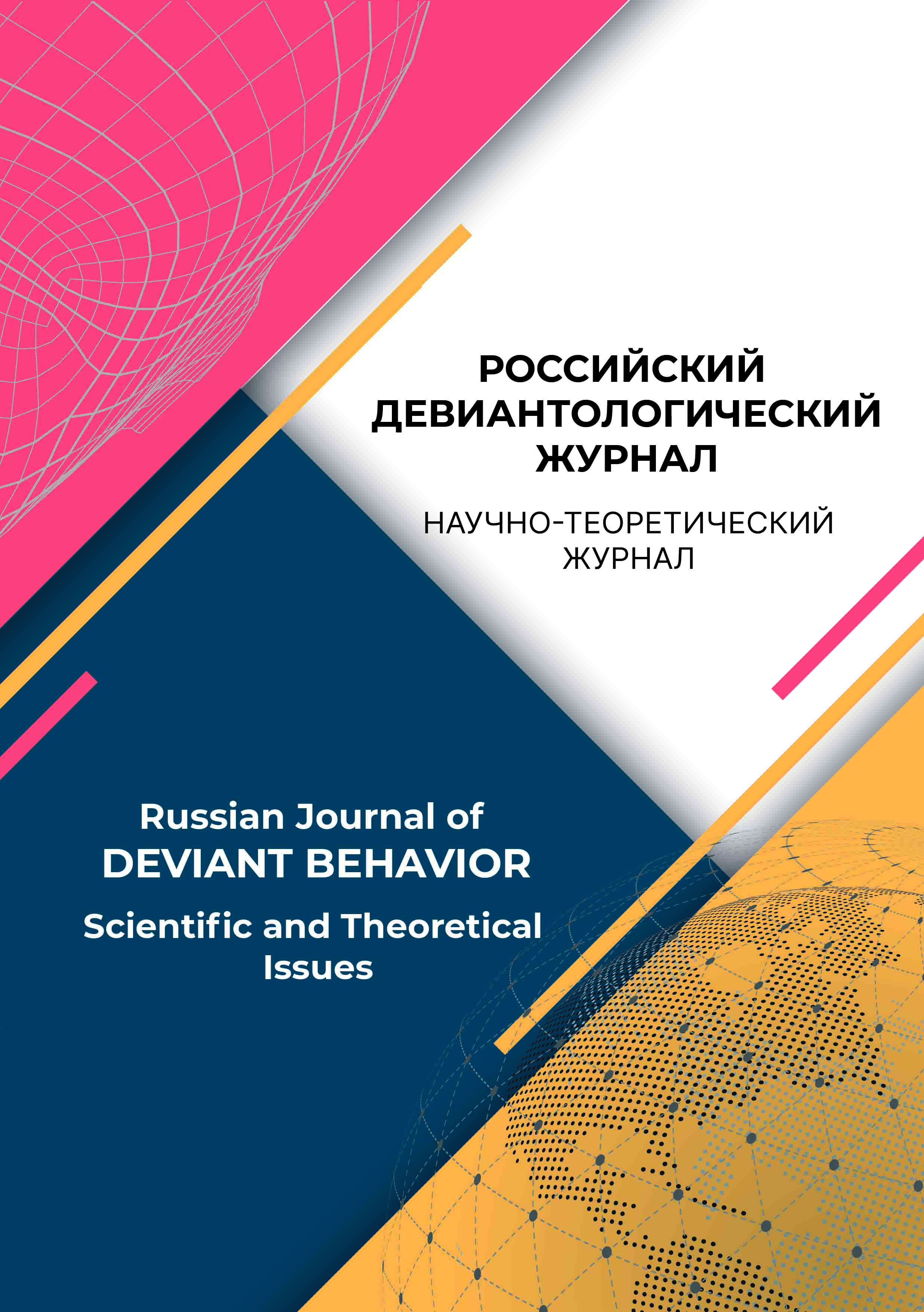employee
Saint-Petersburg, St. Petersburg, Russian Federation
Russian Federation
UDC 159.9.072
Introduction. Smartphones have changed the way people interact with each other in modern society. However, while they are becoming increasingly ubiquitous in human life, there is growing concern that they are often used at inappropriate times during social interactions. The article presents the results of a study of the phenomenon of «phubbing» as a dismissive attitude towards someone in a social environment, when the partner focuses on their mobile phone. Phubbing also significantly reduces the perceived quality of communication and satisfaction with relationships in a dyadic conversation. The article examines an attractive, although still limited, field of research that studies the phenomenon of phubbing in educational organizations of the Ministry of Internal Affairs of Russia. The purpose of the study was to determine the gender characteristics of the manifestation of phubbing in cadets of educational institutions of higher education of the Ministry of Internal Affairs of Russia. Methodology, methods and techniques. A complex of empirical and mathematicalstatistical methods was used to analyze the manifestation of phubbing. Empirical data were obtained using the following methods: Phubbing Scale, consisting of 10 questions (Phubbing Scale, E. Karadağ, et al, 2015); four-factor Generic Scale of Phubbing (GSP), consisting of 15 questions, aimed at assessing the experience of exposure to phubbing. The following factors were identified as important: nomophobia, interpersonal conflict, self-isolation, recognition of the problem; Internet Addiction Test by Kimberly Young (Internet Addiction Test, IAT), translated and modified by V.A. Loskutova (Burova). Statistical processing of the research materials was performed using standard statistical procedures. Specialized application software packages «Excel» and «IBM SPSS Statistics 22.0» were used, providing the calculation of univariate statistics and comparative analysis. The study was conducted at the St. Petersburg University of the Ministry of Internal Affairs of Russia in 2023, among the 1st – 4th year cadets. The sample consisted of 1,054 respondents aged from 17 to 26, the average age was 19.99 ± 1,495, of which 561 were male (53.2%) and 493 were female (46.8%). The results of the study. A comparative analysis of the manifestation of phubbing in male and female cadets showed significant gender differences in the factors «nomophobia» and «recognition of the problem». Based on the negative averages, it can be concluded that there is no phubbing among cadets, which is confirmed by the results of the empirical study. It was also found that male cadets are less prone to phone addiction and recognition of the problem of addiction than female cadets. When studying the gender characteristics of Internet addiction, no significant differences between the sexes were found. Scientific novelty. For the first time, a study of gender features of the manifestations of phubbing in students of educational organizations of the Ministry of Internal Affairs of Russia was conducted. As a result of the study, the socio-psychological symptoms of phubbing in the educational environment were clarified. Practical significance. The obtained research results can be used in the process of training and psychological support of cadets of educational institutions of higher education of the Ministry of Internal Affairs of Russia.
phubbing, Internet addiction, cyberaddiction, virtualization of society
1. Grigor’ev, N. Yu., Chvyakin, V. A. (2021). Fabbing kak neopredelennoe yavlenie v strukture social’noj deviantologii. Gumanitarij Yuga Rossii, 10(2), 27-37. https://doi.org/10.18522/2227-8656.2021.2.2
2. Ekimchik, O. A., Kryukova, T. L. (2022). Adaptaciya metodik izmereniya fabbinga v blizkih otnosheniyah: Shkala fabbinga Karadaga i Shkala partnerskogo fabbinga Robertsa. Konsul’tativnaya psihologiya i psihoterapiya, 30(3), 112-128. https://doi.org/10.17759/cpp.2022300307
3. Zotova, D. V., Rozanov, V. A. (2020). Patologicheskoe ispol’zovanie i zavisimost’ ot social’nyh setej - analiz s pozicij fenomenologii addiktivnogo povedeniya. Vestnik Sankt-Peterburgskogo universiteta. Psihologiya, 10(2), 158-183. https:// doi.org/10.21638/spbu16.2020.204
4. Kozulina, N. S., Karachev, A. Yu. Ahmedzyanova E. V. (2016). Fabbing - neblagopriyatnyj faktor v formirovanii kompetencij u studentov vuzov. Sovremennye issledovaniya social’nyh problem (elektronnyj nauchnyj zhurnal), 10(66), 56-65. https://doi.org/10.12731/2218-7405-2016-10-56-65
5. Maksimenko, A. A., Dejneka, O. S., Duhanina, L. N., Saporovskaya, M. V. (2021). Fabbing: osobennosti addiktivnogo povedeniya molodezhi. Monitoring obshchestvennogo mneniya: ekonomicheskie i social’nye peremeny, 4, 345-362. https://doi.org/10.14515/monitoring.2021.4.1822
6. Ragozinskaya, V. G. (2021). Problema fabbinga v psihologii: obzor nauchnoj literatury. Izvestiya vysshih uchebnyh zavedenij. Ural’skij region, 2, 67-95. EDN: https://elibrary.ru/XZQDNX
7. Usanova, D. O. (2013). Virtual’naya kul’tura: konceptual’nye podhody k osmysleniyu. Vestnik Chelyabinskoj gosudarstvennoj akademii kul’tury i iskusstv, 4(36), 70-75.
8. Hutornoj, S. N. (2013). Setevoe virtual’noe obshchenie i ego vliyanie na mezhlichnostnye otnosheniya. Sovremennye issledovaniya social’nyh problem (elektronnyj nauchnyj zhurnal), 6, 6-9. http://dx.doi.org/10.12731/2218-7405- 2013-6-9
9. Shejnov, V. P. (2021) Vzaimosvyazi zavisimosti ot smartfona s psihologicheskimi i social’no-psihologicheskimi harakteristikami lichnosti: obzor zarubezhnyh issledovanij. Vestnik Rossijskogo universiteta druzhby narodov. Seriya: Psihologiya i pedagogika, 18(1). 235-253. https://doi.org/10.22363/2313-1683-2021-18-1-235-253
10. Yang, K. (2015). Klinicheskie aspekty internet-zavisimogo povedeniya. Medicinskaya psihologiya v Rossii: elektron. nauch. zhurn., 4(33), 2.
11. Baron, N. S., & Campbell, E. M. (2012). Gender and mobile phones in cross-national context. Language Sciences, 34(1), 13-27. https://doi.org/10.1016/j.langsci.2011.06.018
12. Beranuy, M., Oberst, U., Carbonell, X., & Chamarro, A. (2009). Problematic internet and mobile phone use and clinical symptoms in college students: The role of emotional intelligence. Computers in Human Behavior, 25(5), 1182- 1187. https://doi.org/10.1016/j.chb.2009.03.001
13. Berg, J., Dickhaut, J., & McCabe, K. (1995). Trust, reciprocity, and social history. Games and Economic Behavior, 10(1), 122-142. https://doi.org/10.1006/game.1995.1027
14. Campbell, S. W., & Kwak, N. (2010). Mobile communication and civic life: Linking patterns of use to civic and political engagement. Journal of Communication, 60(3), 536-555. https://doi.org/10.1111/j.1460-2466.2010.01496.x
15. Cheever, N. A., Rosen, L. D., Carrier, L. M., & Chavez, A. (2014). Out of sight is not out of mind: The impact of restricting wireless mobile device use on anxiety levels among low, moderate and high users. Computers in Human Behavior, 37, 290-297. https://doi.org/10.1016/j.chb.2014.05.002
16. Choliz, M. (2010). Mobile phone addiction: A point of issue. Addiction, 105(2), 373-374. https://doi.org/10.1111/j.1360- 0443.2009.02854.x
17. Chotpitayasunondh, V., & Douglas, K. M. (2016). How «phubbing» becomes the norm: The antecedents and consequences of snubbing via smartphone. Computers in Human Behavior, 63, 9-18. https://doi.org/10.1016/j.chb.2016.05.018
18. Chotpitayasunondh, V, & Douglas, K. M. (2018). The effects of «phubbing» on social interaction. Journal of Applied Social Psychology, 48(6), 304-316. https://doi.org/10.1111/jasp.12506
19. Cialdini, R. B. (1993). Influence: The psychology of persuasion, Revised Edition. New York, NY: William Morrow and Company.
20. David, M. E., & Roberts, J. A. (2017). Phubbed and alone: Phone snubbing, social exclusion, and attachment to social media. Journal of the Association for Consumer Research, 2(2), 155-163. https://doi.org/10.1086/690940
21. David, M. E., & Roberts, J. A. (2021). Investigating the impact of partner phubbing on romantic jealousy and relationship satisfaction: The moderating role of attachment anxiety. Journal of Social and Personal Relationships, 38(12). 3590-3609. https://doi.org/10.1177/0265407521996454
22. Falk, A., & Fischbacher, U. (2006). A theory of reciprocity. Games and Economic Behavior, 54(2), 293-315. https://doi.org/10.1016/j.geb.2005.03.001
23. Forgays, D. K., Hyman, I., & Schreiber, J. (2014). Texting everywhere for everything: Gender and age differences in cell phone etiquette and use. Computers in Human Behavior, 31, 314-321. https://doi.org/10.1016/j.chb.2013.10.053
24. Ha, Y-M., & Hwang, W. J. (2014). Gender differences in internet addiction associated with psychological health indicators among adolescents using a national web-based survey. International Journal of Mental Health and Addiction, 12(5), 660-669. https://doi.org/10.1007/s11469-014-9500-7
25. Beranuy, M., Oberst, U., Carbonell, X., & Chamarro, A. (2009). Problematic Internet and mobile phone use and clinical symptoms in college students: The role of emotional intelligence. Computers in Human Behavior, 25(5), 1182-1187. https://doi.org/10.1016/j.chb.2009.03.001
26. Jang, M. H., & Ji, E. S. (2012). Gender differences in associations between parental problem drinking and early adolescents’ internet addiction. Journal for Specialists in Pediatric Nursing, 17(4), 288-300. https://doi.org/10.1111/j.1744- 6155.2012.00344.x
27. Karadağ, E., Tosuntaş, Ş. B., Erzen, E., Duru, P., Bostan, N., Şahin, B. M., Çulha, İ., Babadağ, B. (2015). Determinants of phubbing, which is the sum of many virtual addictions: A structural equation model. Journal of Behavioral Addictions, 4(2). 60-74. https://doi.org/10.1556/2006.4.2015.005
28. Karadağ, E., Tosuntaş, Ş. B., Erzen, E., Duru, P., Bostan, N., Şahin, B. M., Çulha, İ., & Babadağ, B. (2016). The Virtual World’s Current Addiction: Phubbing. Addicta: The Turkish Journal on Addictions, 3(2), 250-269. https://doi. org/10.15805/addicta.2016.3.0013
29. Keysar, B., Converse, B. A., Wang, J., & Epley, N. (2008). Reciprocity is not give and take: Asymmetric reciprocity to positive and negative acts. Psychological Science, 19(12), 1280-1286. https://doi.org/10.1111/j.1467-9280.2008.02223.x
30. Lee, Y-H., Ko, C-H., & Chou, C. (2015). Re-visiting internet addiction among Taiwanese students: A cross-sectional comparison of students’ expectations, online gaming, and online social interaction. Journal of Abnormal Child Psychology, 43(3), 589-599. https://doi.org/10.1007/s10802-014-9915-4
31. Lepp, A., Barkley, J. E., & Karpinski, A. C. (2014). The relationship between cell phone use, academic performance, anxiety, and satisfaction with life in college students. Computers in Human Behavior, 31, 343-350. https://doi. org/10.1016/j.chb.2013.10.049
32. McDaniel, B. T., & Coyne, S. M. (2016). «Technoference»: The interference of technology in couple relationships and implications for women’s personal and relational wellbeing. Psychology of Popular Media Culture, 5(1), 85-98. https://doi.org/10.1037/ppm0000065
33. McDaniel, B. T., & Radesky, J. S. (2018). Technoference: Parent distraction with technology and associations with child behavior problems. Child development, 89(1), 100-109. https://doi.org/10.1111/cdev.12822
34. Nazir, T., Bulut, S. (2019). Phubbing: a Phenomenon that is Mending Social Relationships. Sibirskiy Psikhologicheskiy Zhurnal - Siberian journal of psychology, 74, 101-109. https://doi.org /1017223/17267080/74/6
35. Pelaprat, E., & Brown, B. (2012). Reciprocity: Understanding online social relations. First Monday, 17(10). https://doi.org/10.5210/fm.v17i10.3324
36. Przybylski, A. K., & Weinstein, N. (2013). Can you connect with me now? how the presence of mobile communication technology influences face-to-face conversation quality. Journal of Social and Personal Relationships, 30(3), 237-246. https://doi.org/10.1177/0265407512453827
37. Roberts, J. A., & David, M. E. (2016). My life has become a major distraction from my cell phone: Partner phubbing and relationship satisfaction among romantic partners. Computers in Human Behavior, 54, 134-141. https://doi.org/10.1016/j.chb.2015.07.058
38. Tao, R., Huang, X., Wang, J., Zhang, H., Zhang, Y., & Li, M. (2010). Proposed diagnostic criteria for internet addiction. Addiction, 105(3), 556-564. https://doi.org/10.1111/j.1360-0443.2009.02828.x
39. Thelwall, M., Buckley, K., Paltoglou, G., Cai, D., & Kappas A. (2010). Sentiment Strength Detection in Short Informal Text. Journal of the American Society for Information Science and Technology, 61(12), 2544-2558. https://doi.org/10.1002/asi.21416
40. Vanden Abeele, M. M. P., Antheunis, M. L., & Schouten, A. P. (2016). The effect of mobile messaging during a conversation on impression formation and interaction quality. Computers in Human Behavior, 62, 562-569. https://doi.org/10.1016/j.chb.2016.04.005
41. Walsh, S. P., White, K. M., & Young, R. M. (2008). Over-connected? A qualitative exploration of the relationship between Australian youth and their mobile phones. Journal of Adolescence, 31(1), 77-92. https://doi.org/10.1016/j.adolescence.2007.04.004














